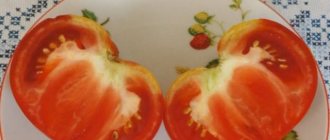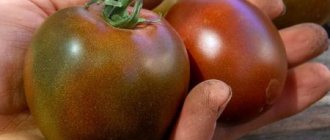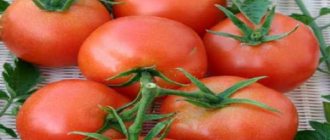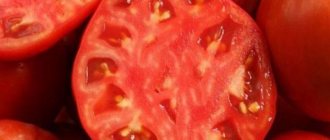Is it possible to fall in love with tomatoes? Yes, if you plant the hybrid Lyubov f1. The time has come for large harvests, pleasant agricultural technology, excellent taste, and resistance to frost and heat. All this will give a new hybrid, adapted for different territories.
| Height | Landing location | Ripening time | Fruit color | Fruit size | Origin | Fruit shape |
| Medium height | Greenhouse, Open ground | Early ripening | Reds | Large | Hybrid | Flat-round |
Description and characteristics of the variety
Tomato Lyubov f1 is a determinate medium-sized hybrid. What properties are inherent in bushes:
- good foliage;
- moderate branching and spreading;
- number of bunches 6-7;
- 4-5 tomatoes per bunch.
Tomato Love height reaches 1.2-1.3 m. The bushes require gartering and shaping.
Characteristics of the fruits of the Lyubov “Siberian Garden” tomato:
- average weight 200-250 g;
- the flesh is fleshy, moderately juicy;
- number of seed chambers 2-4;
- no green spots;
- ribbing is practically not expressed;
- the skin does not crack;
- The taste combines sweetness and sourness.
Ripening dates are early - 98-105 days from germination.
History of selection
Hybrid Love is the result of the work of domestic breeders. Originator Panchev. Included in the register since 2006
It can be grown in open beds and in protected greenhouse conditions. In the north they are planted in heated greenhouses.
Reviews
Inna: “For several years in a row I have been giving preference directly to the Lyubov variety tomatoes. And I can’t get enough of my own harvest. One bush produces up to 6 fruits. The taste is rich and sweet. Diseases must be fought with pharmaceuticals or folk recipes. Therefore, I can recommend it as one of the best varieties of tomatoes.”
Elena: “I have been looking for the best varieties of tomato for a long time. The love variety was recommended by a neighbor. Fruit ripening is surprisingly fast. I collect up to 6 kg from a bush. To prevent various diseases, after moving the bushes to a permanent place, they are treated with the substance “Fitosporin”. If symptoms of the disease occur, the infected bushes must be eliminated by throwing them outside the garden. The fruits are very tasty and last a very long time. Before this, my family mainly preferred Cherry, but these tomatoes replaced them. And it’s not so difficult to grow them, water them more, tie them up. You can plant, but the harvest will be smaller. But the tomatoes themselves will be large in size. I recommend it to gardeners and even beginners in growing crops.”
Popular: Planting, care and use of exotic okra in the ground
Currently reading:
- Proper cultivation of Adenium succulent with your own hands
- Variety of shapes and colors of Calathea from the Marantaceae family
- Big and tasty harvest with Dutch Romano potatoes
- Foreign, sweet raspberry hybrid for the garden plot
Share the news on social networks
About the author: Vladimir Petrovich Efremov
Chief agronomist of the limited liability company “Association of Peasant (Farm) Farms “Kuznetsovskaya””, Ilovlinsky district of the Volgograd region.
Features of cultivation and storage
Bushes Lyubov f1 are transplanted into stationary beds at the age of 55-60 days.
The soil is fertilized per 1 m2:
- 1 bucket of compost;
- 1 glass of ash;
- 30 g superphosphate;
- 10 g potassium sulfate.
To disinfect the bed from fungi, the bed is pre-treated with 1% Bordeaux mixture or Fitosporin.
What points to observe when growing:
- bushes are placed at a distance of 45-50 cm, the distance between rows is 70 cm;
- stepchildren 1 time in 10 days;
- form into 2 shoots;
- tied to trellises or supports.
Fertilizing is carried out 2 times a month, always at the stages of flowering, setting and ripening. Phosphorus-potassium composition, nitrogenous compounds, organic solutions are used - 1:10 diluted mullein or dung.
Gives a good effect:
- bioinfusions with nettle;
- yeast starter;
- infusion of eggshells.
Tomato Love: planting and care
Tomatoes are usually grown in seedlings, but under very favorable climatic conditions, the seeds can be planted directly in open ground. But in almost all regions of our country, it is best to grow tomatoes through seedlings. It should be said that the main advantage of the Lyubov tomato variety is the approximate time for obtaining the first harvest. It is best to plant tomatoes in nutrient soil. The area for planting tomato seedlings Lyubov is prepared in the fall, humus and organic matter are added to the soil, but it is best to plant the seedlings in universal soil. Sowing seeds should begin at the end of March; if you subsequently replant the plants in a greenhouse, it is best to plant Lyubov tomato seedlings in early spring. First, the tomatoes are planted in one common box, container, and the seeds are planted to a depth of 2 or 3 centimeters. Usually, shoots appear early, after about 5 days, in order for the Love tomato seedlings to develop more actively, you will need to cover the boxes with film or glass before the sprouts appear, in order to create favorable climatic conditions inside.
When each plant has a pair of true and strong leaves, the plants will need to be picked into separate containers. After 2 days it will be possible to feed the tomatoes for the first time. For this, you can purchase either ready-made fertilizers or prepare the fertilizer yourself. You will need to water the tomatoes as needed, best done late in the evening. About two weeks before the planned date of planting tomatoes in open ground, you should begin to harden off the plants. To do this, you will need to take the boxes out into the open air every day, increasing the time the seedlings spend outside. But remember, in extreme heat or rain, seedlings should be left in a dark and protected place.
Tomatoes Love: photo of variety
Tomato seedlings Lyubov are usually planted in open ground at the age of 60 days. By this time, buds may already have formed on the plants. If the foliage darkens in color and there is a small distance between the axils, then the seedlings are ready for planting. If your plants are pale and very elongated, this means that the seedlings did not have enough light. It will be much more difficult for such tomatoes to adapt to new conditions. It is advisable not to pinch the top, and excess stepsons should be removed. Moreover, in open ground you don’t have to leave additional shoots at all, so the fruits will be larger and the yield higher. Take care of the support in advance; it is advisable to dig a wooden peg near each plant, so that in the future you can tie up the spreading branches of the bushes. Sometimes you can install supports using tensioned wire. But remember, it is best to tie the plants with hemp thread to avoid damaging the fragile stems.
It is best to plant seedlings in open ground in a square-nest method, in a checkerboard pattern, and there should be more free space between the rows than between individual tomatoes. It is best to plant the beds from east to west, so that the plants receive equal sunlight throughout the day. This variety of tomatoes is quite sensitive to the level of soil acidity, so when acidification occurs, it is recommended to lime the area.
If we talk about fertilizing Lyubov tomatoes, it is best to add fertilizer containing nitrogen, phosphorus, and potassium to the soil. You can fertilize the plants for the first time 2 weeks after transplanting the seedlings into open ground. This is done to give the plants time to adapt. Sometimes the soil is fed with ash for the first time; for this, one glass of fertilizer is diluted in 10 liters of water, and the resulting solution is watered on the tomato bushes. You can add potassium sulfate to the soil; it is best to do this in spring or autumn. Since with moisture, beneficial substances will gradually approach the roots of the plants, because it is small doses that are beneficial for the growth of tomatoes. Remove weeds from the site in a timely manner.
Gardeners recommend mulching the soil with straw and dry grass. Thanks to this, the soil dries out less and weeds do not grow. Tomatoes of the Lyubov variety are recommended to be watered about twice a week with warm water. But do not overdo it; if the soil is over-moistened, the ovaries may fall off and the root system may rot. You can plant basil or coriander next to the beds; these herbs perfectly attract bees, which also pollinate tomatoes, but this spice repels pests. As you remember, a support should be installed near each brush so that the shoots are not overloaded. Secure the fruits with twine, but remember, you should not do this too tightly, as you can damage the plants.
To prevent the Lyubov tomato ovaries from falling off, it is recommended to treat the above-ground part of the plants with a solution of boric acid. They need to spray the leaves and stems, observing the dosage. After the fruits begin to fill, there is no need to add organic fertilizers to the soil. Otherwise, you will simply harm the plants, since nitrogen promotes the growth of green mass, but it is not needed for the formation of ovaries. During this period, it is recommended to water the tomato bushes with a solution of water, wood ash, boric acid and iodine. After the first tassel of tomatoes has formed, it is recommended to remove the leaves near it. It is best to do this in the morning so that the damage can dry out during the day.
When the Lyubov tomatoes turn red, they can be harvested. But you can also pick green tomatoes from the branches so that they can ripen later. This is done in order to transport fruits over long distances. It is best to leave green tomatoes of the Lyubov variety to ripen in a warm room, but the humidity there should be low, otherwise the tomatoes will spoil. In order to preserve the harvest, they should be sent to a cool room where the air temperature will not be higher than plus 15 degrees.
Advantages and disadvantages
Among the advantages of the hybrid:
- resistance to return frosts;
- high productivity;
- wonderful taste;
- low light resistance;
- good tolerance to drought and heat;
- excellent tying regardless of weather conditions;
- stress resistance;
Of the minuses:
- need for regular feeding.
The main advantages of this tomato variety:
- high level of productivity;
- early ripening;
- transportability;
- resistance to cracks;
- possibility of cultivation in many regions;
- resistance to diseases and pests;
- high taste properties;
- versatility;
- resistance to moisture deficiency.
However, the Love variety also has certain disadvantages:
- high demand for fertilizers during growth;
- the need for a sufficiently strong support;
- need for tying.
There are quite a lot of varieties and hybrids of tomatoes similar to the one under consideration; it is nothing outstanding, but, like any modern hybrid, it has many more advantages than disadvantages.
The fruits of the Love tomato are ordinary small red balls
The advantages of the Love tomato are:
- excellent presentation of the fruit;
- evenness of tomatoes, i.e. all tomatoes are approximately the same size;
- good transportability;
- no cracking under any conditions;
- good drought resistance;
- increased resistance to diseases;
- excellent taste, not always typical for tomatoes of this shape and size;
- versatility of application.
Among the disadvantages of the hybrid, they note the not very good yield, which strongly depends on the fertility of the soil, as well as the need for the formation and staking of bushes, which can be dispensed with for many determinate varieties.
Differences from other varieties
When considering the Love tomato, you need to be very careful and critical of the information provided on the Internet. And this is not only a matter of malicious intent, but often also of carelessness: there are several varieties of tomatoes with similar names:
- Earthly love by the same author, bearing fruit with tomatoes weighing at least 200 g;
- Lyubushka: this variety has a high yield, but the taste of fresh fruit is rated only as good;
- hybrid My Love by breeder L.A. Myazina, which has nothing to do with the tomato in question;
- Novosibirsk variety Early Love, most of the indicators of which, with the exception of the ripening period, are similar to those of the Lyubov tomato.
Tomato Early love does not need gartering or pinching The fruits of the tomato Earthly Love reach a weight of 200 g Tomato My love easily tolerates drought and temperature changes
Some information about the plant
The characteristics and description of the variety are as follows:
- Obtaining the first harvest of the described tomato is possible 105-110 days after planting the seedlings.
- If the plant is grown in open ground, then the height of its bush is 1.1-1.2 m, and when growing a tomato in a greenhouse, this figure increases to 130 cm.
- A large number of leaves appear on the bushes. They are medium in size. The leaves are colored standard green.
- The first brush is formed around 7, sometimes 9 leaves. It is recommended to leave the stepsons in these places in order to obtain the desired shape of the bush. The description of the variety provides for the formation of 2 stems from the left shoot. All other stepsons must be removed. They should not be pinched until they reach a length of 5-7 cm. In this case, a stump up to 5.0 mm high is left in place of the removed shoot.
- Tomato fruits weigh on average from 220 to 250 g. Growing bushes in a greenhouse allows you to obtain berries weighing up to 0.4 kg.
- Love tomatoes are shaped like a ball, painted in bright shades of red. The color of the berries is uniform, there is no green spot in the area of the stalk. The skin is thick enough to prevent the fruit from cracking.
Those farmers who planted and grew the described variety note that the yield of these tomatoes ranges from 16 to 20 kg/m².
The hybrid is resistant to various diseases. In the absence or lack of moisture, a plant does not shed ovaries and flowers.
Reviews from gardeners have shown that tomato grows well in open ground in the southern regions of Russia. In the vast expanses of the middle zone and Siberia, this variety is recommended to be grown in greenhouses or film greenhouses. The harvest can be transported over medium distances. Berries are stored in a cold cellar for 15-20 days.
The disadvantage of the variety is the strong dependence of plants on fertilizers. In the absence or small amount of fertilizing, the harvest volume decreases sharply.
See also
Description of the Malinovka tomato and agricultural cultivation techniques
Read










